Not all blue birds are actually bluebirds. West of the Rocky Mountains, it’s common for casual birdwatchers to confuse Western Bluebirds with another blue-colored bird – the Lazuli Bunting. Because both Western Bluebirds and Lazuli Buntings are small songbirds with blue wings, distinguishing between the two species can be challenging for new birdwatchers. In this article, I’ll provide you with a comprehensive guide to help differentiate between these two delightful songbirds – Western Bluebirds and Lazuli Buntings.
What’s the difference between Western Bluebirds and Lazuli Buntings?
Western Bluebirds have a small, insect-eating bills, and Lazuli Buntings have larger, conical, seed-eating bills. Lazuli Buntings also have white and black marks on their blue wings. Western Bluebirds have blue wings with orangish-red markings extending onto the shoulders. Both birds have a blue head and wings, an orange chest, and a white belly.

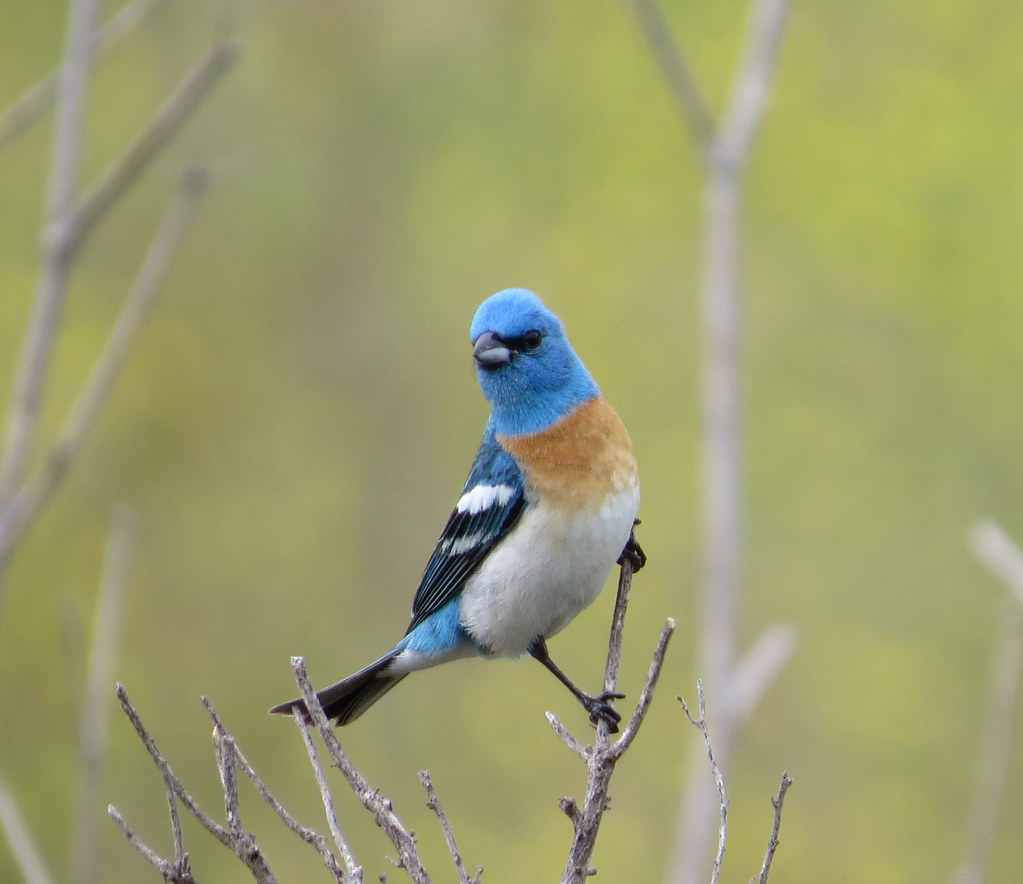
Photo of “Male Western Bluebird” is accredited to Gregory Smith, used under license CC BY-SA 2.0.
Photo of “Male Lazuli Bunting” is accredited to Kaaren Perry, used under license CC BY 2.0.
In this article, I want to go over a few of the key differences between Western Bluebirds and Lazuli Buntings. Hopefully you’ll be able to identify each of these birds in your back yard the next time you see them!
Table of Contents
- Where Do They Live? – Western Bluebirds vs. Lazuli Buntings
- Where to Look for Them
- Physical Differences
- Nesting Differences
- Do Western Bluebirds and Lazuli Buntings Get Along?
- Conclusion
Where Do They Live? – Western Bluebirds vs. Lazuli Buntings
Western Bluebirds – Typical Range
Generally speaking, Western Bluebirds reside across the western half of North America, extending north into Canada during the breeding season, and south into Mexico year-round. They received their name, the Western Bluebird, because, when compared to the other two species of bluebirds, they tend to only live west of the Rocky Mountains. Learn more about all three species of bluebirds in this article here.
The yellow and green portions of the map below show the Western Bluebird’s breeding range and year-round range respectively. The blue portion of the map shows their migratory range during the non-breeding season.
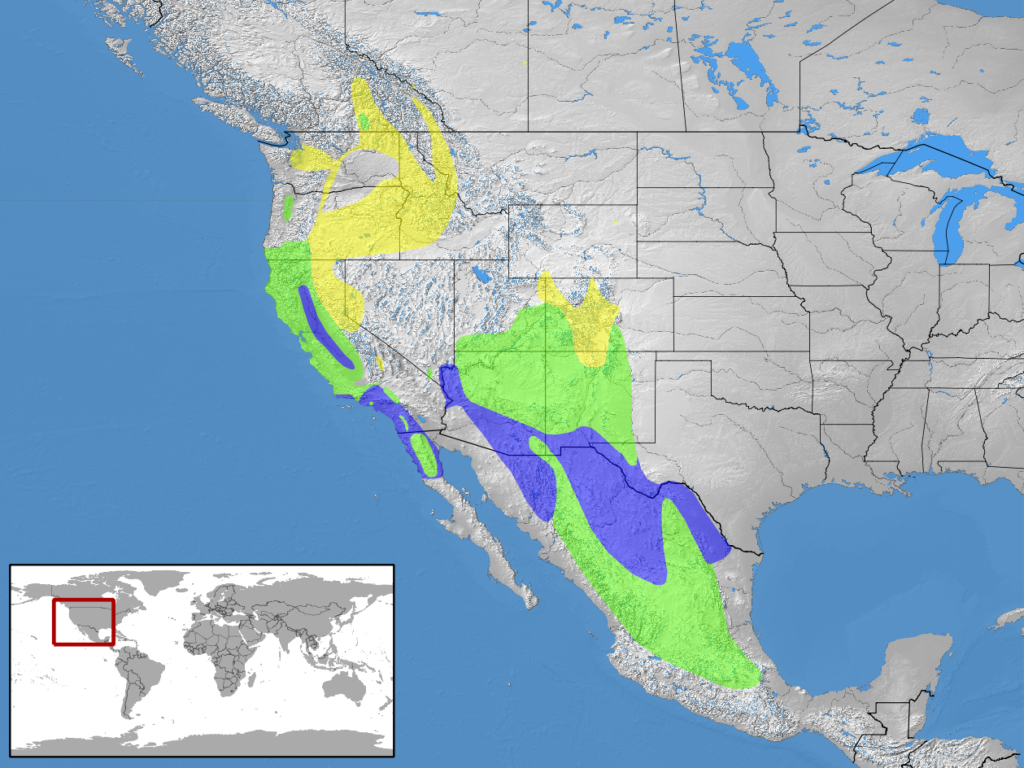
Lazuli Buntings – Typical Range
Lazuli Buntings can also be found throughout the western half of North America.
The orange portion of the map below indicates Lazuli Buntings’ typical range during breeding season. Yellow indicates their migratory range and blue shows their non-breeding year-round range.

As you can see, there are certainly some overlapping areas in North America where Western Bluebirds and Lazuli Buntings can be found in the same place.
Assuming you’re in the North American west, let’s talk about where you will typically find each of these two species of birds.
Where to Look for Them: Western Bluebirds vs. Lazuli Buntings
Where to Look for Western Bluebirds

Western Bluebirds prefer to spend time in open areas with sparse amounts of vegetation and scattered trees. Open areas with short grass are ideal for bluebirds since this makes it easy for them to catch insects on the ground.
As cavity-nesters, Western Bluebirds prefer to live where there are plenty of natural tree cavities or artificial nest boxes present. It is quite a common sight to encounter Western Bluebirds out in the country perching on fence posts, telephone wires, and low tree branches, scanning for insects on the ground. When they spot an insect, they’ll usually swoop down, grab the insect with their beak, and then flutter back up to their perch to enjoy their catch.
You can look for Western Bluebirds in the following places:
- Edge of fields
- Golf course
- Fence posts
- Low perches
- Telephone wires
Where to Look for Lazuli Buntings

While Western Bluebirds prefer open areas with scattered trees, Lazuli Buntings frequent rather brushy habitats. According to the Cornell Lab of Ornithology, Lazuli Buntings “live in brushy hillsides, areas near streams, wooded valleys, thickets and hedges along agricultural fields” (source). Overall, they have a preference for brushy and wooded areas, whereas Western Bluebirds prefer more open, grassy habitat.
You can look for Lazuli Buntings in the following places:
- Hedgerows
- Brushy roadsides
- Nesting in shrubs
- Tree tops
- Telephone wires
- Bird feeders
Now, let’s consider the physical differences between Western Bluebirds and Lazuli Buntings.
Physical Differences: Western Bluebirds vs. Lazuli Buntings
Western Bluebird Physical Characteristics
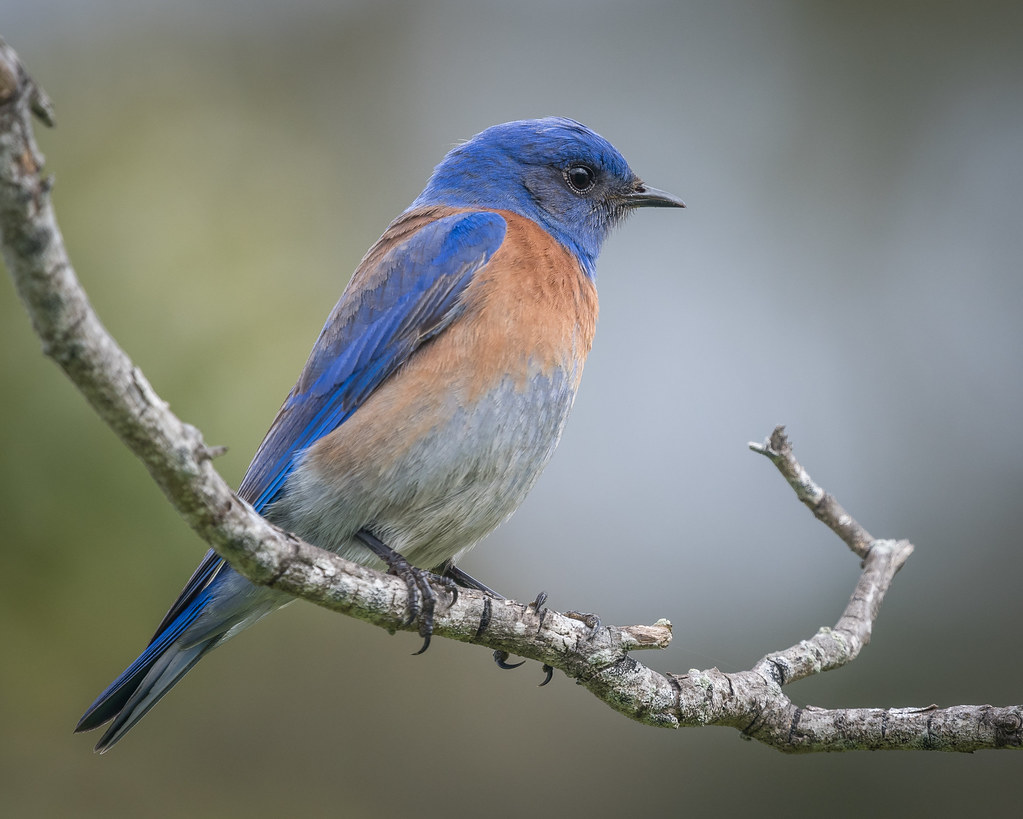

Male Western Bluebird Photo by Becky Matsubara is licensed under CC BY 2.0.
Female Western Bluebird Photo by PEHart is licensed under CC BY-SA 2.0.
When it comes to size, Western Bluebirds are approximately two-thirds the size of an American Robin. The Western Bluebird is as a small thrush, similar to the Robin, with a distinctive rounded head, a short, straight bill, and blue wings.
Male Western Bluebirds have bright blue plumage with a rusty-colored breast and a white stomach. The females are slightly larger than their male counterparts with duller brownish-gray feathers and a slight blue hue on their wings and tail feathers.
Quick Tip: Look at the beak! The bird’s beak (or “bill”) is a great way to immediately spot the difference between a Western Bluebird and a Lazuli Bunting. Bluebirds have small, delicate, insect-eating beaks (see photos above). Contrast that with the pointier, triangular-shaped, seed-eating beaks of Lazuli Buntings. Check out the bluebird photos above and the bunting photos below to see the difference.
Lazuli Bunting Physical Characteristics


A male Lazuli Bunting has brilliant blue plumage, a sloping forehead, an orange-colored breast, a white belly, and a white patch on its wings. Adult males are the bluest of the species and are the easiest to confuse for being a bluebird.
Adult female Lazuli Buntings, on the other hand, are medium-brown in color with dark brown wings. Since they are so brown in color, if you are expecting a blue bird you will probably look right past the female Lazuli Bunting. Juvenile birds, both male and female, are also various shades of brown.
The Lazuli Bunting’s large, triangular-shaped, seed-eating bill differentiates this bird from the small-billed, insect-eating Western Bluebird.
Diet Differences: Western Bluebirds vs. Lazuli Buntings
Western Bluebird Diet

Photo by Becky Matsubara is licensed under CC BY 2.0.
Most of the Western Bluebird’s diet is composed of caterpillars, spiders, and crickets, and other insects. They’ll also eat mealworms when they’re offered at a feeder. Although they are mostly insect-eaters, bluebirds are omnivorous. As the weather gets colder and insects become more scarce, Western Bluebirds will shift to eating berries and certain seeds during the winter.
Some of their preferred winter foods include blueberry, honeysuckle, juniper berry, and wild holly. Western Bluebirds can also be attracted to a bird feeder year-round that is stocked with live mealworms, their favorite food. You can see the bluebird feeders and mealworm sources I that I use on my Recommended Tools page here.
Lazuli Bunting Diet
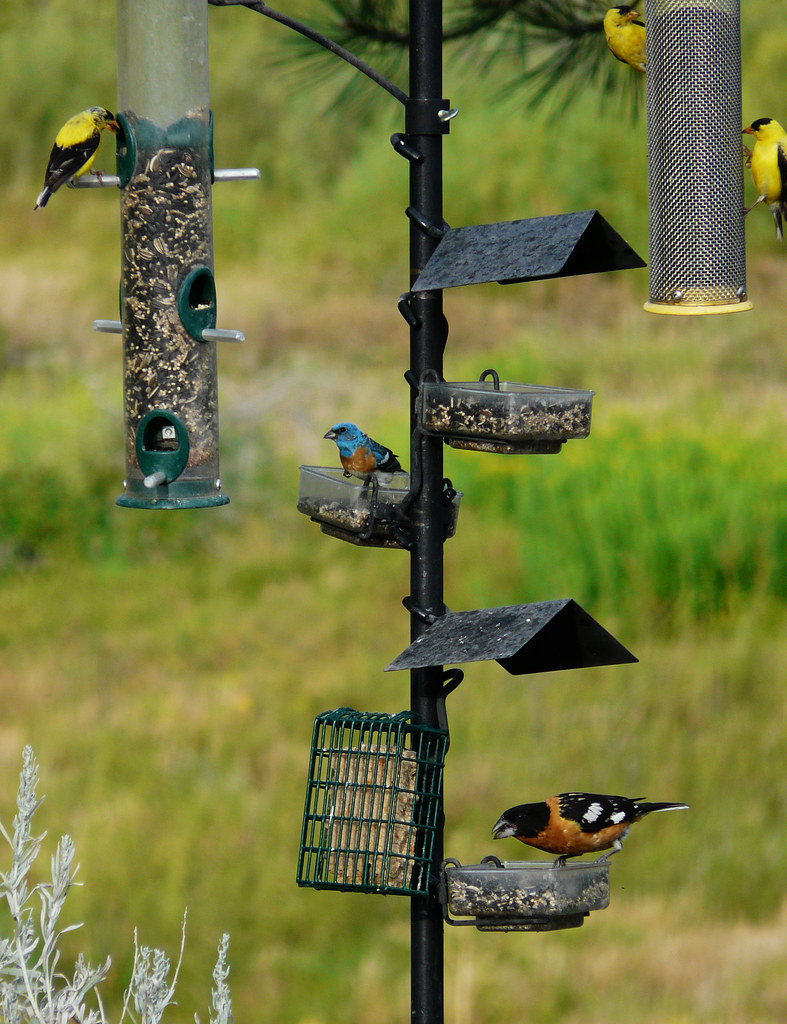
Lazuli Buntings are omnivorous. They pluck caterpillars, spiders, crickets, and other insects off of low low-standing grasses and leaves, but they also eat different types of berries and seeds when they can find them. (Hence the seed-eating beak).
They’re easy birds to spot at bird feeders as well. Lazuli Buntings are especially attracted to bird feeders that are stocked with white proso millet (which is also attractive to doves and quail).
It’s probably a Lazuli Bunting at your bird feeder. While both species of birds are omnivorous, you’re most likely to see Lazuli Buntings at a standard bird feeder filled with bird seed. Western Bluebirds will sometimes take hulled sunflower seeds from a bird feeder, if they’re available, but bluebirds don’t visit bird feeders as often as Lazuli Buntings.
Nesting Differences: Western Bluebirds vs. Lazuli Buntings
Western Bluebird Nests
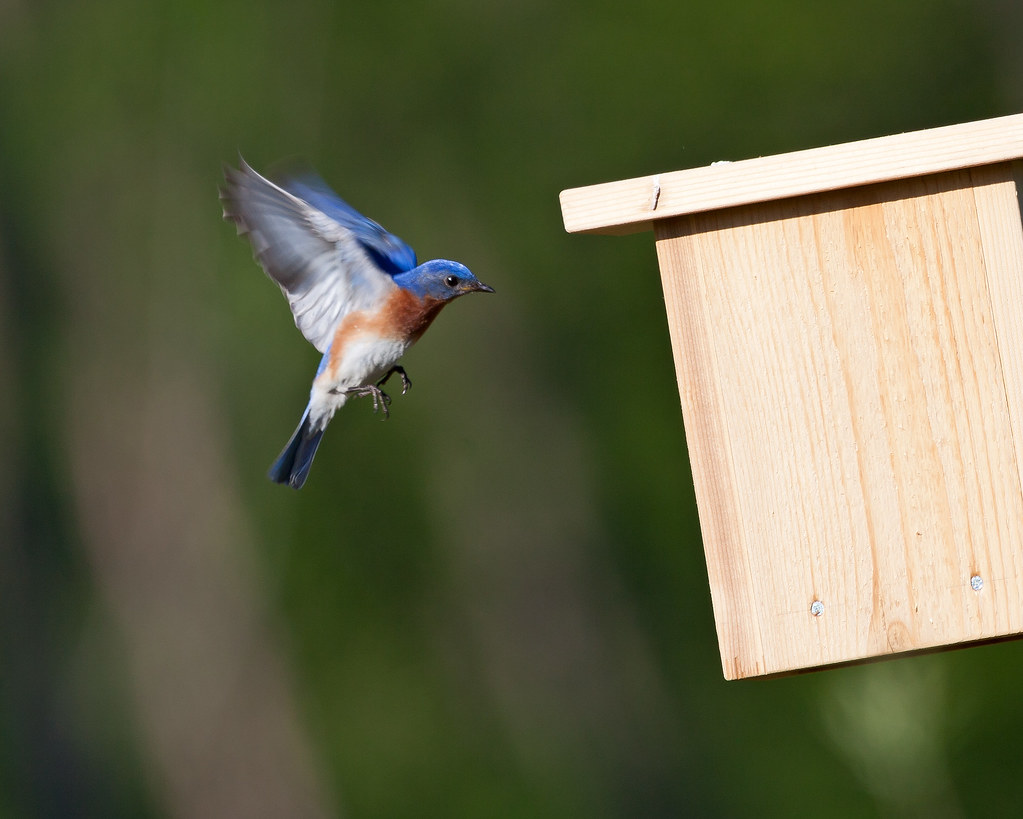
Western Bluebirds are cavity nesters. This means that they only build their nests in bird houses or in natural cavities (usually holes in dead trees or old woodpecker holes). Since they are cavity nesters, Western Bluebirds are unable to build nests on the branches of trees like many other birds do. So, if you see a bright blue bird going in-and-out of a hole in a tree, or in-and-out of a bird house, it’s probably a bluebird!
Once Western Bluebirds have found a suitable nesting site, the female will complete the nest by weaving together dried grasses, pine needles, and other natural materials. Female Western Bluebirds will lay about 3-5 pale blue or white eggs per clutch that she will then incubate for 11-19 days. After the eggs hatch, both Western Bluebirds will continue to feed their young for around 17-21 days until they leave the nest.

The great thing about cavity-nesting birds like Western Bluebirds, is that you can actually attract them to your yard by putting up a bird house for them to build their nest in. Learn more about how you can attract Western Bluebirds to your yard with a bird house in the article that I wrote here, called: How to Attract Bluebirds.
Lazuli Bunting Nests

Instead of nesting in cavities, Lazuli Buntings typically choose a shrub in which to build their nest, and usually no more than three feet off the ground. Female Lazuli Buntings build their nests alone out of leaves, grasses, and bark. Then they weave the nests together with spiderwebs or similar material (source).
The female Lazuli Bunting will lay about 3-4 pale blue, greenish-blue, or pure white eggs per clutch. The incubation period for the eggs is 11-14 days and the young birds will spend and additional 9-14 days in the nest (source).
Do Western Bluebirds and Lazuli Buntings Get Along?
As a general rule, Western Bluebirds and Lazuli Buntings do get along. Since they do not compete for food or nesting sites, the two species rarely interact. Unless they become territorial over a food or water source, it is unlikely that Western Bluebirds or Lazuli Buntings will harm one another.
Conclusion
There is no denying that both Western Bluebirds and Lazuli Buntings have some physical similarities. Mainly, male Western Bluebirds and male Lazuli Buntings both have bright blue plumage. However, both species are distinct in their specific color markings, and they each have different nesting and diet preferences. Regardless of their differences, they are both beautiful birds to spot in your back yard.
If you’re interested in attracting bluebirds to your back yard, check out my article called How to Attract Bluebirds here.


